Mushrooms are a strange breed. They aren’t vegetables. They aren’t herbs. And they aren’t fruits, either — at least not in the traditional sense. In fact, mushrooms are the fruiting bodies of various types of fungi that grow on wood or soil.
Mushrooms have a complex, savory flavor known as “umami.” Because it’s neither salty, sweet, sour or bitter, umami is sometimes called “the fifth basic taste.” And it’s highly prized in cooking for its ability to balance, deepen and round out the other flavors in a given dish (think steak with mushrooms). For more on umami, search for it in our search engine.
Most fresh mushrooms are easy to work with in the kitchen. They generally require only a few minutes to cook, but they can stand up to longer cooking times, too — for example, in a stew — without falling apart or losing their flavor.
Mushrooms offer all kinds of health benefits, too. Studies show that mushrooms, including both exotics and common supermarket varieties, can be helpful in warding off inflammation, arthritis, cancer and heart disease.
Read on for some easy, delightful and unexpected ways to enjoy mushrooms, from white button to cremini, portobello and shiitake.
Mushroom Picking
There are thousands of varieties of edible mushrooms, and they grow all over the world. In the wild, these fleshy fungi grow on naturally decaying organic matter, usually in moist environments. But because so many wild mushrooms are poisonous, it’s wise to leave mushroom picking to the experts.
Most of the mushrooms you’ll find at the grocery store have been cultivated. Many are grown on manure-based compost, so it’s important that you wipe off or rinse these mushrooms before eating them. But don’t soak them in water, or expose them to soap. Both can be absorbed and negatively affect the mushrooms’ flavor.
Here’s a look at four common mushroom varieties featured in our recipes below:
- White Button: Common white button mushrooms are the most predominantly available in grocery stores. Harvested year-round, they are at their peak in the fall and winter. They have a savory, woodsy flavor that gets stronger when cooked.
- Cremini: Creminis (also called criminis, baby bella or baby portobello mushrooms) are similar in size and texture to white button mushrooms. They are coffee colored and have a slightly deeper, earthier, meatier taste.
- Shiitake: These have a rich, earthy flavor that’s reminiscent of garlic and pine. Lightly sauté whole or sliced caps, then simmer in a little liquid, like stock or white wine. Discard the stems, which can be tough, or use them to make broth.
- Portobello: The name “portobello” is given to full-grown cremini mushrooms. They have a stronger flavor than creminis. Because of their size, they’re especially good for grilling or roasting. The stems are edible; just trim off the ends.
Nutrition Know-How
- Mushrooms boost the immune system and protect against cardiovascular disease and cancer. Some mushrooms, especially button, cremini and portobello mushrooms, also help regulate inflammation.
- Mushrooms contain all of the amino acids essential for human nutrition, which make them an excellent choice for vegetarians and vegans.
- Rich in antioxidants and other phytonutrients, mushrooms are also a good source of minerals like potassium (which helps control blood pressure) and phosphorus (a mineral that generates energy and is essential for strong bones and teeth).
- Studies have found that mushrooms may contain high levels of vitamins B12 and D, but those amounts are variable.
- Some mushrooms, like shiitake, have antiviral, antifungal and antitumor effects.
Kitchen Tricks
- Use a soft, damp towel to remove soil and grit from mushrooms. If necessary, right before using, give mushrooms a light rinse and pat dry.
- When sautéing, try not to overcrowd mushrooms; otherwise, mushrooms will steam instead of caramelizing.
- Add salt toward the end of sautéing mushrooms, because salt draws out moisture and can prevent caramelization if added too early in the cooking process.
- One more trick to guarantee caramelization? Make sure your pan and oil are properly heated before tossing in the mushrooms.
- Keep dried mushrooms on hand for adding flavor to sauces or soups. To rehydrate, place in warm water and let stand for 30 minutes. Lift from water, rinse, chop and add to the dish you’re cooking. (The soaking water is super flavorful. If the mushrooms are going into a soup or sauce that calls for liquid, use the soaking water after you strain it well through cheesecloth.)
Shopping and Storage Tips
- When purchasing mushrooms, look for ones that are firm and evenly colored. Avoid mushrooms with slimy spots, darkened surfaces, wrinkles or signs of damage.
- Immediately after purchase, place mushrooms in a brown paper (not plastic) bag in the main compartment of your refrigerator (the vegetable drawer is too moist for them). Stored this way, they’ll usually keep for up to a week or two.
- Dried mushrooms can be stored in a cool, dry place for up to six months.
Quick and Easy
- Sauté: Mushrooms cook quickly and make an excellent side dish or topping for meats, pastas or veggies. Sauté sliced, diced or whole mushrooms in butter or olive oil over medium-high heat until they are soft and start to release their juices. For variety, add fresh herbs or a little garlic.
- Marinate: Steam mushrooms and toss them with your favorite vinaigrette. This is a great way to preserve mushrooms. Keep them on hand for a quick addition to salads or antipasti trays.
- Stuff: For an appetizer, bake mushroom caps stuffed with your favorite fillings, like olive caponata, ratatouille, or turkey sausage and cheese.
- Grill: Large portobello mushroom caps can be grilled and used as the main ingredient in vegetarian sandwiches.
- Make Stock: Some types of mushrooms can be pricey, so if you feel bad about discarding the stems, save them and make a stock to use as a base for soups: Simmer mushroom stems, carrot, celery and onion together in enough water to cover; strain before using. For a flavorful miso soup, simmer 1 teaspoon sesame oil or olive oil, 2 tablespoons minced onion, 1 teaspoon grated gingerroot, 3 thinly sliced shiitake mushroom caps, 1/4 cup shredded kale, 2 cups mushroom stock, and 1 to 2 tablespoons miso (white, brown or red).
Recipes
Spinach Salad With Grilled Portobello Mushrooms
When portobello mushrooms are grilled, they develop a meaty flavor. In this vegetarian version of a steak salad, the heat of the grilled mushrooms slightly wilts the spinach. If you would rather use another salad green, cool the grilled mushroom slices to room temperature before tossing together.
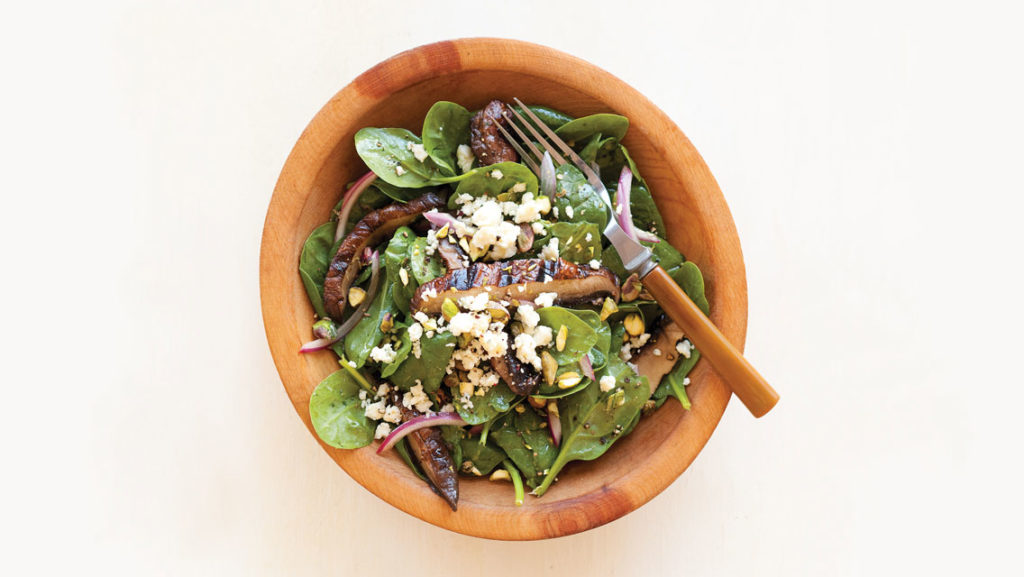
Serves | two as a main dish, four as a side salad
Ingredients
- 2 tbs. sherry vinegar
- Juice of 1 lemon
- 2 tbs. extra-virgin olive oil
- Salt and pepper to taste
- 2 large portobello mushroom caps (stems removed)
- 6 cups spinach (5 ounces), washed and trimmed
- 1/2 cup thinly sliced red onion
- 1/3 cup toasted pistachios, lightly chopped
- 4 ounces crumbled bleu cheese
Directions
- Mix the sherry vinegar, lemon juice, olive oil, and salt and pepper together, then marinate the mushroom caps in this mixture for a half hour. Remove mushrooms from the marinade and then reserve the marinade.
- Heat a grill pan, or an electric or gas grill, and grill the mushroom caps for three to five minutes on each side. When they are beginning to soften, remove from the grill and slice into thin strips, about 1/4 inch.
- Toss the mushroom slices in the reserved marinade, then toss with the remaining salad ingredients, except the cheese.
- Top with crumbled bleu cheese.
For variety, try different greens, nuts and cheeses (such as romaine, pecans and shredded cheddar, or baby field greens, toasted sliced almonds and chèvre).
Wild Mushroom Omelet With Arugula and Chèvre
This quick, satisfying meal can be made with or without pancetta (unsmoked bacon). As alternatives to arugula, try baby spinach or watercress. For more fresh flavor, add chopped fresh herbs, like chives or marjoram, to the egg mixture.

Makes | two omelets
Ingredients
- 1 tsp. extra-virgin
- olive oil
- 4 slices pancetta or bacon, diced
- 3 cloves garlic, sliced
- 3.5 ounces shiitake mushrooms or other wild mushroom, sliced
- 1/4-inch thick
- 2 tbs. clarified butter (ghee) or olive oil
- 6 eggs
- Salt and pepper to taste
- 3/4 cup coarsely chopped arugula or baby arugula leaves
- 4 ounces chèvre
Directions
- Heat olive oil in a medium sauté pan over medium heat.
- Add the diced pancetta and cook until beginning to brown. Add the garlic and mushrooms and sauté until mushrooms are lightly browned.
- Remove the mushrooms and pancetta from heat and set aside.
- Heat an omelet pan with clarified butter over medium heat.
- Beat eggs in a small bowl and season with salt and pepper. Pour half of the eggs into the omelet pan and cook until egg is set, gently lifting edges of egg with a rubber spatula and swirling the pan gently to allow runny egg to go to the edge and flow into the pan. When the egg is almost set, top with half of the mushroom pancetta mixture, arugula and chèvre. Using a rubber spatula, fold the omelet in half, and slide it out onto a serving plate. Repeat with the remaining eggs and filling.
Beef Roast With Cremini Mushrooms in Zesty Pomegranate Sauce
Serve this slow-cooked roast with a hearty whole grain, such as cooked quinoa, wild rice or barley. Pair with braised cabbage, Brussels sprouts or kale. For a vibrant and healthful touch, garnish with pomegranate seeds.
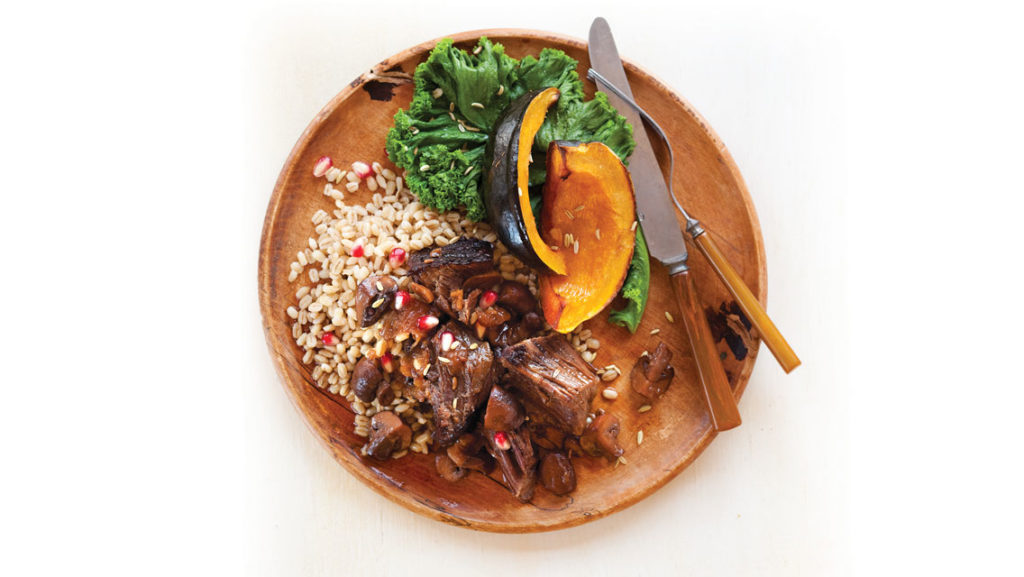
Serves | four to six
Ingredients
- 1 tbs. extra-virgin olive oil
- 2 pounds chuck roast
- Salt and pepper to taste
- 1 yellow onion, sliced crosswise in ½-inch slices
- 6 cloves garlic, crushed
- 8 ounces cremini mushrooms, quartered
- 1 tbs. fennel seed
- 2 tbs. pomegranate molasses
- 1/2 cup red wine
- 1 cup beef broth
- 1 cup pomegranate seeds
Directions
- Preheat oven to 350 degrees F.
- Heat olive oil in a 4-quart Dutch oven. Wash roast, pat it dry, and season with salt and pepper.
- Sear the roast in the Dutch oven for about five minutes on each side. Remove the roast and set aside, keeping warm by tenting loosely with foil.
- In the same Dutch oven, sauté the onion, garlic, mushrooms and fennel seed for five minutes.
- Meanwhile, mix pomegranate molasses with red wine and broth. Return the roast to the Dutch oven. Pour the broth mixture over the roast and simmer for five minutes. Then cover the pot and place in the oven.
- Roast for 3 to 3 1/2 hours, checking occasionally and turning the meat in the pan. When the roast is very tender, remove from the oven. Allow the meat to rest for 10 to 15 minutes before slicing.
- Serve with the broth and top with the pomegranate seeds.
Sweet and Sour Braised Portobello Mushroom Caps With Asian Greens and Brown Rice
This comforting dish combines the tangy, earthy tastes of pineapple juice, tamari, fresh gingerroot and sesame oil.
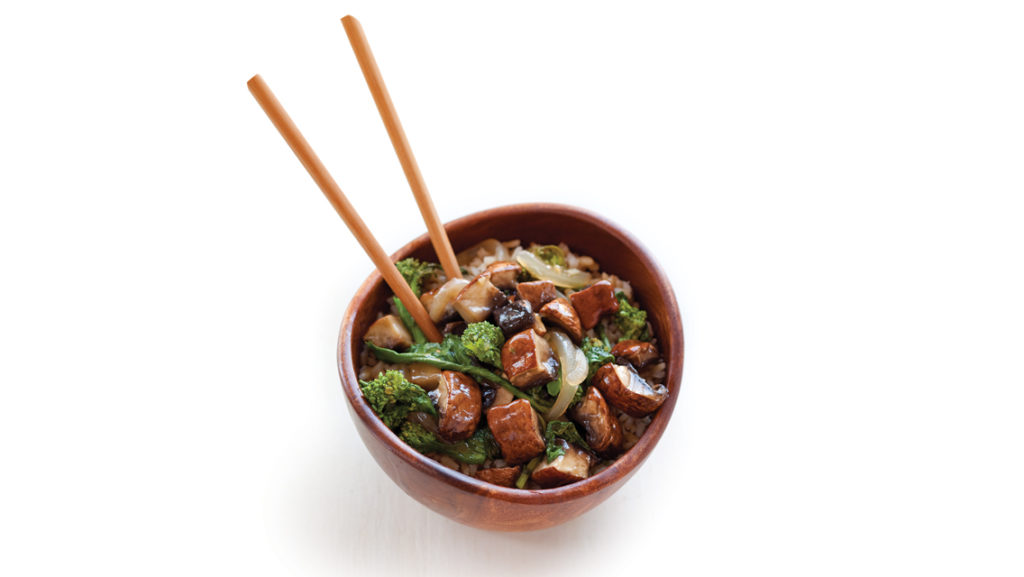
Serves | four to six
Ingredients
- 1 cup pineapple juice
- 1 tbs. honey
- 1 tbs. tamari
- 1/4 cup rice wine vinegar
- 2 cups cubed portobello mushroom caps (about 2 large caps), or 2 cups sliced mushrooms of your choice
- 1 tbs. sesame oil
- 1 yellow onion, thinly sliced
- 2 tbs. minced gingerroot
- 1 tsp. toasted sesame oil
- 4 cups roughly chopped Asian greens, such as baby bok choy, napa cabbage, or Chinese broccoli
- 1/2 cup vegetable stock
- 1 tbs. potato starch
- 6 cups cooked brown rice
Directions
- Make a marinade with the pineapple juice, honey, tamari and rice wine vinegar. Marinate the mushrooms for about a half hour.
- Remove mushrooms from marinade, reserving marinade for later.
- Heat sesame oil in a large sauté pan or wok, and add onion, gingerroot, toasted sesame oil and mushrooms. Sauté until mushrooms soften.
- Add the Asian greens and sauté until they’re wilted, then add the reserved marinade liquid and vegetable stock.
- Separately, mix the potato starch with 1/4 cup water. When the liquid in the sauté pan begins to simmer, add the potato starch mixture and stir until thickened.
- Serve mushrooms and greens over brown rice.
A Mushrooming Business
After Jeremy McAdams spent some time growing mushrooms in plastic bags for the fun of it, he decided to start growing them on stacks of logs in his Minneapolis backyard. “I love wood, so mushroom farming really appealed to me,” he says. Today, McAdams delivers his Cherry Tree House Mushrooms harvest to local restaurants and grocery co-ops, teaches mushroom cultivation workshops, and sells logs inoculated with mushroom spores to people who want to grow their own mushrooms.
EL: How many varieties of mushrooms do you grow?
JM: I have several strains of oyster mushrooms: blue, gray, brown and yellow ones. And I usually have at least a couple of strains of shiitake as well.
EL: How do you describe a mushroom’s subtle taste?
JM: Mushrooms have a savory and perhaps woodsy flavor, and many of them taste sweet or nutty.
EL: Do oyster mushrooms really taste like oysters?
JM: Not at all. Oyster mushrooms are called that because of their shell-like appearance, not because of their flavor. Oysters are lighter in flavor compared with the meaty quality of shiitake mushrooms.
EL: What’s the difference between a cultivated mushroom and a wild mushroom?
JM: Wild mushrooms don’t depend on intervention for them to grow. You forage them, usually in the woods. But it is possible to cultivate some wild mushrooms. Shiitake are easy to cultivate; so are oyster mushrooms, and a few others.
EL: How long does it take to produce a cultivated mushroom?
JM: I inoculate logs in the spring, then I’ll start to get fruitings after a few months. My production peaks in the late spring and early fall. Summer is too hot for a
lot of mushrooms. If you get foraged mushrooms, it tends to be more in
the spring and the fall, when the conditions are right.
EL: Should you wash mushrooms before you eat them?
JM: I pick the mushrooms right off the logs, which are clean, and I put them in a bag and they go to the buyer. So basically, I wouldn’t wash mushrooms grown on logs. Beyond that, I know that Agaricus bisporus mushrooms — which are the white button mushrooms, cremini and portobello — are grown on manure in many cases. I would look into how these mushrooms are cleaned before they arrive at the store if you are a lover of raw agaricus. (See “Kitchen Tricks” for tips on how to clean mushrooms.)
EL: Do you have a favorite mushroom dish?
JM: I like making pizza with a couple varieties of mushrooms, and sometimes I’ll add
in green olives. I’ll make quiche or omelets with mushrooms, and I do like miso soup with shiitake. My wife and I usually have bacon drippings around, so we fry mushrooms lightly in bacon fat. It’s important not to dry out mushrooms too much when you’re sautéing them. If there’s not enough oil, you’ll end up with mushroom crisp.
All recipes were created by Betsy Nelson — a.k.a. “That Food Girl” — a Minneapolis-based food stylist and recipe developer.
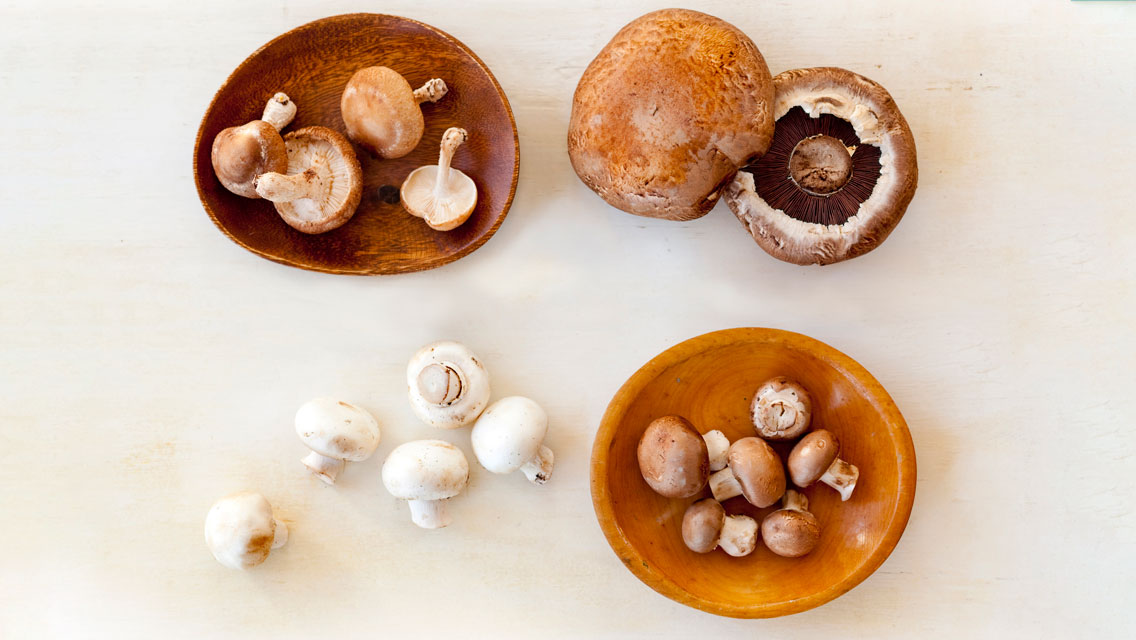

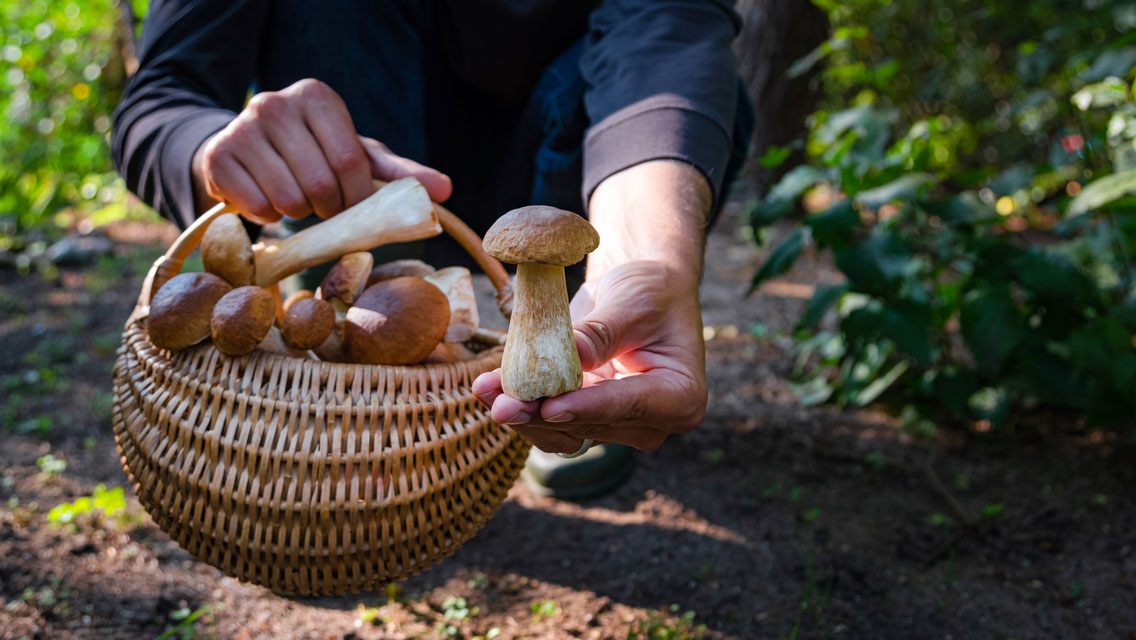
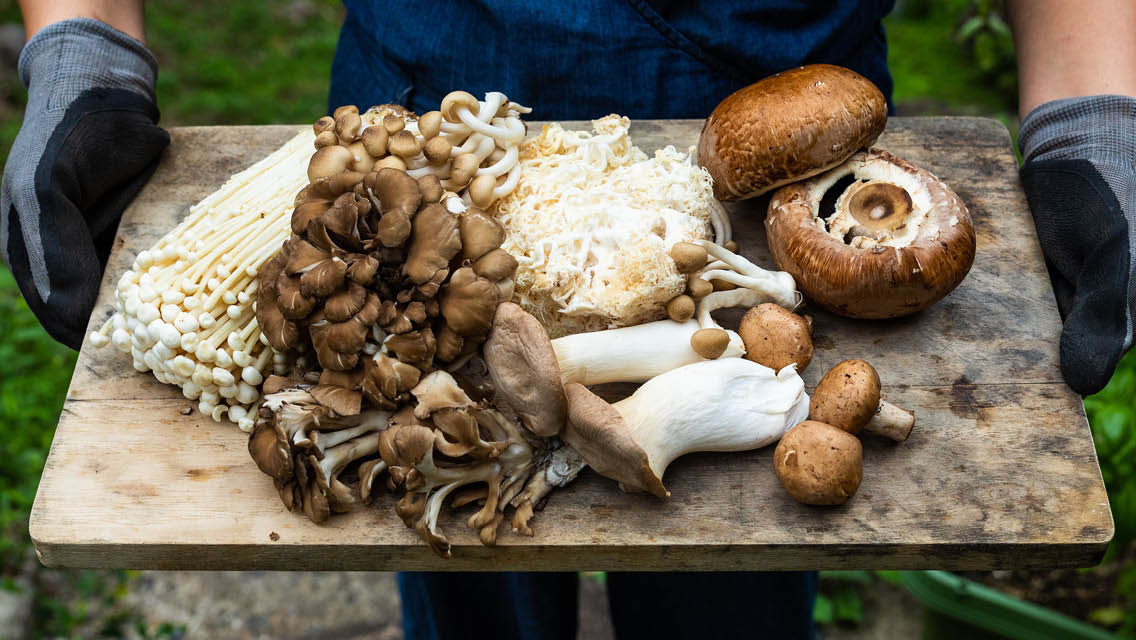
This Post Has 3 Comments
[…] and beans. There are plenty of ways to fake a ‘meaty’ meal with plant options like portobello mushrooms, vegetable and nut patties, and well-seasoned […]
[…] your cravings for chargrilled eats by tossing a handful of mushrooms, peppers, and zucchini onto the grill. HCAs and PAHs don’t kind when grilling […]
[…] your cravings for chargrilled eats by tossing a handful of mushrooms, peppers, and zucchini onto the grill. HCAs and PAHs do not type when grilling […]